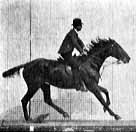
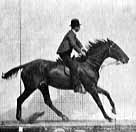
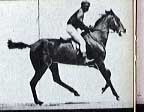
Once an animal is airborne, its center of mass follows the physical laws of any other projectile. The center of mass moves over the jump in a parabola. If the animal has a good sense of timing, the highest point in the parabola is over the jump.
While the center of mass moves in a parabola once the animal has pushed off the ground, the center of mass may be moved within the animal's body by motion of the extremities. The center of mass is shifted forward and downward if the horse stretches its neck forward and down, for instance. Movement of the legs will also have an effect, though not as much. To clear a high jump, the animal must put the parts of itself most likely to intersect the jump - generally its feet - as high as possible relative to the center of mass while they are over the jump. The animal has the further problem of landing safely, which is in large part controlled by the angle its longitudinal axis takes relative to the horizontal. This in turn is determined by the direction of the animal's thrust with the fore and hind feet when it is leaving the ground.
Finally, it is important to realize that the animal must apply force over a distance to lift its center of mass against gravity. This requires that the limb applying the force must lengthen during the thrusting phase, something usually managed by applying the thrust from a bent position. (Try to push off a wall if you start with your arms straight and don't flex your wrists.) This is quite obvious in the rear legs. Probably the front thrust comes from closing and opening the joint between the shoulder blade and the upper arm, though that is not as obvious from these pictures. In any event, the amount of thrust needed from the forehand is not nearly as much as that from the hindquarters.
The horse in these Muybridge photographs is jumping a rather low hurdle, and the rider's style, typical of a hundred years ago, interferes with the horse's ability to use its head and neck as freely as a good jumper does today. Several of the early stages of the jump have photos of the corresponding canter positions on the right side.



Last canter stride before the jump. For comparison, the same phase of a normal canter is shown at the right.
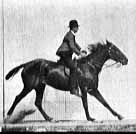
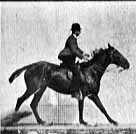
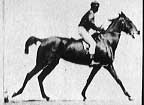
Diagonal support in the final stride before the jump. Compare with the same phase of the normal canter on the right. The front end of the horse preparing to jump appears to be lowered slightly, and the forelegs appear to be set in a braking action. Probably the shoulder angle between the shoulder blade and the upper arm is closed slightly more than usual.
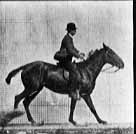
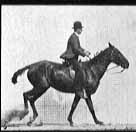
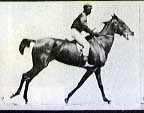
Support is shifting to the forehand, with both hind legs off the ground. The rear legs are more flexed than in the normally cantering horse to the right, the braking action of the front end continues, and the momentum of the center of mass helps the horse thrust its rear legs much farther forward than would be the case in this phase of a normal canter.
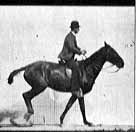
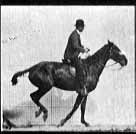
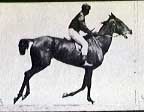
The hind legs are still well forward of their position at this phase of a normal canter (right). The foreleg support phase is much longer than in the canter, which probably helps close the shoulder angle and store elastic energy. By the middle photograph the withers are starting to rise a bit as the horse starts to push off with his front legs.
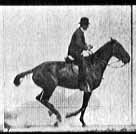
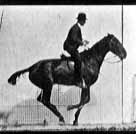
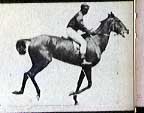
Note the difference between the body axis during the lead forleg pushoff and that of the corresponding phase of the canter. In the canter the horse is more or less falling forward over the supporting leg. In the jump, the horse is actively pushing downward with the lead foreleg, rather than vaulting over it. The hind feet are almost lined up and well under the jumping horse. The hind foot has not yet touched down, and the horse may be airborne for a fraction of a second before it does. However, the contracted suspended phase before a jump is much shorter than the contracted suspended phase of a normal canter. Note that the forehand thrust does more than lift the horse's center of mass. Since the thrust is through a line in front of the horse's center of mass, it also rotates the horse's body axis so that the front is higher than the rear. If no other forces were applied, the horse would continue to rotate (counterclockwise in these photos) and would be quite unable to get its forelegs down for a landing.
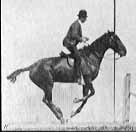
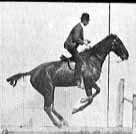
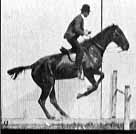
Continued rotation of the body as the hind legs touch down and the hindquarters flex. The forelgs are tucking up to get the front hooves as high as possible relative to the center of mass during the actual passage over the jump. A horse jumping without interference from its rider would began to drop the head at this point, lowering the center of gravity relative to the front hooves to assist this process.
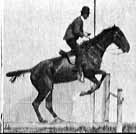
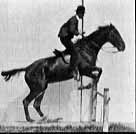
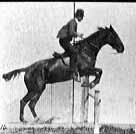
The hind legs continue to flex, giving the impression the horse is "sitting" on them. In the third frame, the horse is beginning to thrust with the hind legs, which are straightening out. Note that the thrust of the hind legs is slightly behind and above the horse's center of mass. This opposes that counterclockwise rotation of the horse's long axis, slowing and then reversing it to that during the airborne phase of the jump the horses front end will move downward relative to the rear end.
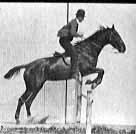
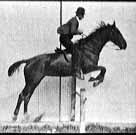
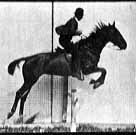
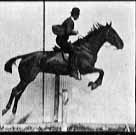
Final thrust and takeoff. From here on, the trajectory of the center of mass is a parabola and the horse has no control over the movement or its angular momentum. It can only shift the position of its body and legs relative to the center of mass. Note how much the flexed hind legs have straightened. during the pushoff. This is the end of that particular Muybridge sequence. The jump continues with a different set of photographs of the same horse and rider, but the transition between the the last photo above and the first photo in the next series shows some differences in the placing of the legs and the degree to which the body has rotated back to the horizontal.
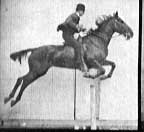
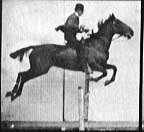
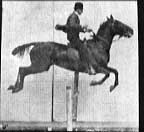
Forelegs begin to drop and reach forward for the landing after clearing the jump. Hind legs are beginning to tuck in order to clear the jump. Note that the rotation of the body puts the shoulders high at the time the front end is over the jump, and the hindquarters high at the time the rear legs are over the jump.
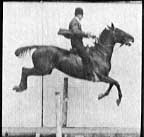
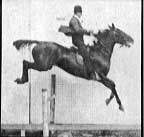
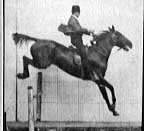
Continued downward and forward reach of forlegs, continued rotation of body and tuckup of rear hooves to get them as high as possible relative to the center of mass.
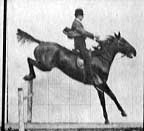
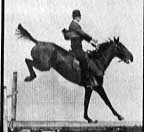
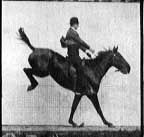
Rear hooves clear this rather low jump just as the non-lead front leg starts to touch down. Note the extreme flexion of the pastern on the landing leg. Lead leg starts to take weight.
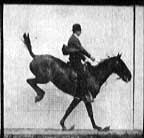
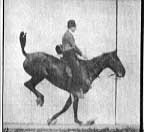
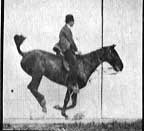
The force of landing on the forehand has produced enough upward force ahead of the center of mass to rotate the body back toward the horizontal. Without this change of rotation direction, the horse would be in danger of falling on its face.

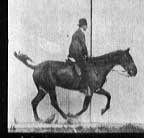
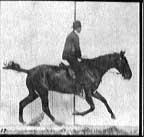
Transition from the landing back to the canter. In the canter this would be a suspension phase, and I believe that in some jumps the horse would actually push off with the lead front foot before the non-lead hind foot touched down. In this case, however, there is no contracted suspension phase.
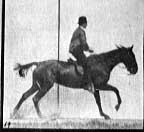
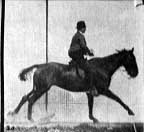
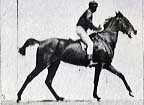
Cantering away from the jump. In the first stride after landing, the horse has nearly made the transition to the normal canter shown in the right-hand image.